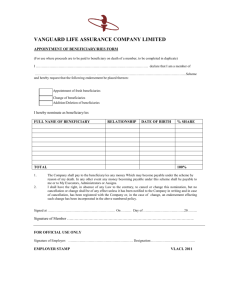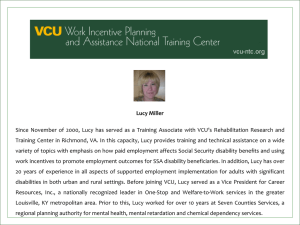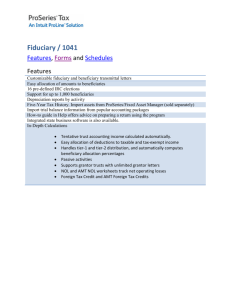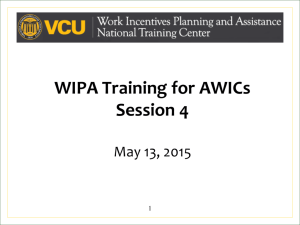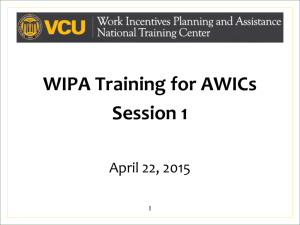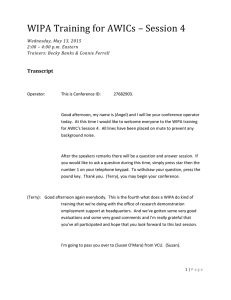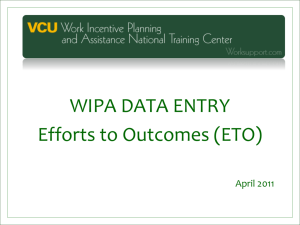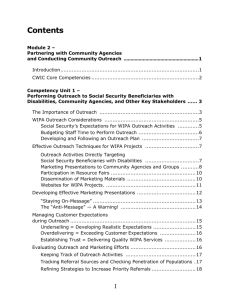Supporting Beneficiary Progression along the Employment Continuum
advertisement
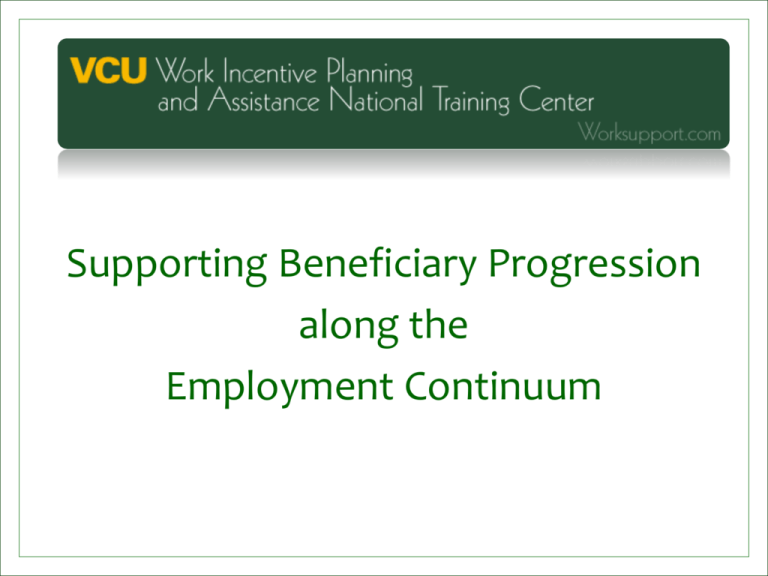
Supporting Beneficiary Progression along the Employment Continuum Learning Objectives • Identify and describe the 4 stages of progression along the employment continuum, including the identifying characteristics, informational needs, and successful counseling strategies for each stage. • Describe the role of the CWIC in supporting beneficiaries to move forward along the employment continuum. • Identify the 4 main points of the WIPA “message” to be communicated to beneficiaries as well as the most important message to avoid during work incentives counseling. Learning Objectives - continued • Describe what “just in time” work incentives counseling is and give examples of WIPA services which represent this concept. • Understand how to apply “just in time” WIPA services and avoid “too much information syndrome” in the development of Benefits Summary & Analysis and Work Incentives Plans. • Identify and describe specific strategies for keeping beneficiaries engaged with the CWIC over time as they move forward along the employment continuum. • Identify and describe specific strategies for providing proactive WIPA services which enhance employment retention. The Mission of WIPA • Promote employment and enhance self-sufficiency. – Focus benefits counseling services on issues directly related to employment. – Increase the number of beneficiaries who choose to work, – Support those beneficiaries in successfully maintaining employment over time, and – Provide work incentives assistance which enables beneficiaries to increase their earnings capacity. What is the Employment Continuum? • A series of stages that an individual may go through to realize their employment goals. • Individuals may be at various places on the continuum when they seek WIPA services. EMPLOYMENT ^ JOB SEARCH ^ PREPARATION CONTEMPLATION Stages of the Employment Continuum • Contemplative Stage – Just beginning to think about the possibility of going to work – No clear vocational goal – Typically fearful of impact of work on benefits • Preparatory Stage – Decision has been made to pursue paid employment – Initial steps have been taken to prepare for employment – There is a clear occupational goal set – Steps to achieve the goal have been identified Stages of the Employment Continuum continued • Job Search Stage – Actively participating in job search activities – Has a clear vocational goal – Has completed preparatory steps (education, training, etc) – Could be receiving employment services or assistance from a job developer – Potential job offers on the table • Employment Stage – Already working or self employed – May be recent or long-term employment – May be experiencing a problem causing them to consider quitting – Considering possible promotion or job change Role of the CWIC in Promoting Employment • Actively encourage paid employment • CWICs are “pro” employment – work is GOOD! • Be an employment cheerleader • Balance emphasis on paid employment and common sense • Provide information and advisement that encourages the beneficiary to take the next step • Provide necessary supports over time to ensure that barriers are reduced • Show beneficiaries how to apply work incentives that increase the financial benefit of working Myths about the WIPA Initiative • All disability beneficiaries MUST go to work. • Beneficiaries who do not choose to work are “bad” or “wrong”. • A higher value is place on those who pursue work at higher levels. • Only those who are pursuing work at a level to preclude cash benefits are worthy of services. NONE of these statements are true or are part of the WIPA value system! We encourage, promote, assist, and support forward movement towards employment. Questions for the CWIC to Consider • What is the next step along the road to employment and what can I do to help him/her commit to taking that step? • What information do I need to provide at this juncture to facilitate progression along the continuum? • Are there any barriers to employment this person faces related to public benefits and what can I do to minimize those barriers? • What specific services or supports can I provide to help this beneficiary to move forward on their employment journey? • What other members of the employment support team do I need to coordinate with to enhance the effectiveness of efforts to promote employment? Strategies for Success • Stay “on message” • Avoid the “anti-message” • Watch out for TMI Syndrome – too much information • Provide “just in time” work incentives counseling What is the “Message”? • Paid employment and SSA disability benefits are NOT mutually exclusive – beneficiaries do not have to choose between one or the other. • It is possible to work (even full time) and keep Medicaid and/or Medicare in almost every case. • It is possible to work and come out ahead financially even if public benefits are reduced or even ceased. • It is possible to get benefits back again if they are lost due to employment. WARNING – the “Anti-Message” • The intent of WIPA is NOT to keep individuals on disability benefits indefinitely. • It is NOT the CWICs job to “save” beneficiaries from benefit termination due to employment at all costs. • CWICs should NOT present information in ways that cause beneficiaries to unnecessarily fear working above SGA, earning wages over the SSI break-even point, or earning more than the 1619(b) threshold amount. • CWICs should NOT routinely encourage beneficiaries to suppress their wages or net earnings from self employment. • It is NOT the CWICs duty to find some way – any way – to reduce countable earnings to avoid cessation or termination. Be honest! TMI Syndrome – Too Much Information • There is no need to “tell it all” right off the bat. • Worry over covering ALL possible bases often causes information overload – avoid giving detailed explanations of every possible provision or work incentive that could ever potentially apply. • Beneficiaries can easily become totally overwhelmed and intimidated by the volume and complexity of the information being presented. • Being overwhelmed = increased fear of benefits loss • End result is typically a decision NOT to work, and possibly causes the beneficiary to avoid future contact with the CWIC. “Just in Time” Work Incentives Counseling • Just in Time = not too early and not too late • Learning will only occur when the individual is ready to learn because the need to apply the information is at hand. • “Just in time” benefits counseling provides the right type of information and support needed to help the individual move forward along the employment continuum. • Small doses of relevant information at the appropriate time will result in ongoing support and assistance to help the beneficiary realize their employment goals. • Also helps the WIPA project to meet SSA’s goal of providing long term case management services to beneficiaries. Documentation and the Employment Continuum • Questions for the CWIC to consider: – What stage is the individual currently in? – What is the most effective way to provide follow up information to the beneficiary to help them to move forward? – Is a Benefits Summary & Analysis necessary at this point? – If a BS&A is appropriate, what depth of information is needed so that “just in time” learning can occur? – What is the best format for the beneficiary to understand the information being presented? Documentation – Contemplative Stage • Provide a general letter about the initial contact to include: – The mission of WIPA – Review of specific questions asked – Fact sheets and publications as appropriate – Reminder to reconnect when the decision to pursue employment is made – Information about where to get help with career exploration – Blank releases with instructions on completion and return – A thank you for contacting the program • Provide a general BS&A if it would be the deciding factor to help an individual move forward towards employment Documentation – Preparatory Stage • Develop a pre-employment / preparatory Benefits Summary & Analysis to include: – Verification of benefits – Identification of issues to be resolved – Current standings in relation to work incentives already used – Referrals to appropriate employment support providers – Identification of potential steps to be taken to reach the desired work goal – Identification of work incentives that can help the individual to achieve the work goal (PASS) Documentation – Job Search Stage • Develop a Benefits Summary & Analysis to include: – Verification of benefits – Resolutions of previous issues identified during preparatory stage – Current standings in relation to work incentives already used – Follow up on job search activity assistance previously provided – Identification of work incentives that can help the individual to achieve and maintain the job desired – Provide example calculation sheets to demonstrate the impact of earnings on benefits – Offer options • REMINDER – this may be simply an update to the pre-employment BS&A previously prepared Documentation – Employment Stage • Develop a Benefits Summary & Analysis to include: – Verification of benefits – Current employment situation (# of hours working, rate of pay) – Plans for job change, or identification of issues causing potential job loss or reduction of hours – Impact of the applicable work incentives – Reporting instructions – Potential solutions to the barriers that could cause loss of employment – Description of future safety nets that can be utilized Following Up – Providing Proactive WIPA Services Where the beneficiary is on the employment continuum will help determine…. • • • • Whether or not follow-up is needed When to follow-up (critical transition points) How often to make follow-up contacts What methods to use in conducting follow-up Using 30-60-90 Day Schedules • One size does NOT fit all. If you are using a standardized follow-up approach for everyone, you are not conducting follow-up properly. You have to think about what makes sense for that person. • SSA does NOT expect CWICs to contact every beneficiary on a regular pro-active basis. Do what is necessary to help the person move forward along the continuum toward employment! • The most common situations in which standard 30-60-90 day (or similar) follow-up schedules should be used are when a PASS plan is being developed/managed, and for individuals who have recently become employed. • Be aware that excessive pro-active contacts may be viewed as annoying or intrusive. If you call, do so after work hours. Try to use email whenever possible. Even snail mail can be effective Periodic Follow-Up • Most follow-up contacts will be triggered by critical transition points. CWICs need to know what points apply to each beneficiary and should plan for contacts when these points are near. • In some cases, the CWIC will have to wait for the beneficiary to indicate when transition points have been reached. CWICs must clearly describe the points at which beneficiaries are expected to make contact and WHY contact is necessary. Write this down in the BS&A! • If you don’t hear from someone who is in the employment preparatory stage or job search stage by the time you would have expected for a transition point to occur – call them! Relying on the Employment Support Team • CWICs cannot support beneficiaries in isolation – you must work closely with other members of each person’s employment support team and keep lines of communication open at all times. • If beneficiaries do not respond to your attempts to make contact, contact members of the employment support team. Make certain you have obtained signed releases allowing you to share information. • VR counselors, supported employment professionals, case managers, etc. are essential contacts for CWICs. CWICs must develop working relationships with these people if we are to achieve our shared goal of promoting employment and enhancing self-sufficiency. Reminders • Be prepared to identify where a beneficiary currently is on the continuum and develop strategies to help them to move forward. • WIPA clients do not always follow a straight path through each of the stages on the employment continuum. • Some beneficiaries will leap two steps ahead and go directly from contemplation to employment, and others will chug along one step at a time. • Remember that sometimes backward progress must be made before forward progress can continue. • Every beneficiary has a unique set of circumstances and needs – CWICs must be flexible!

